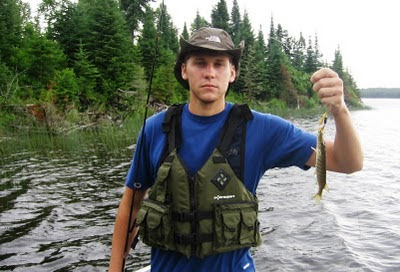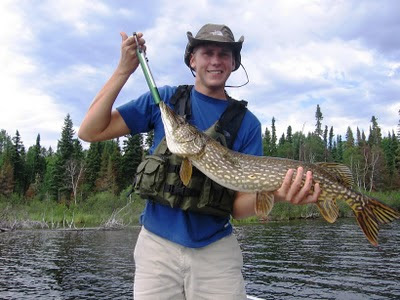


Casting for northern pike is, in my opinion, the most productive method of catching these tremendous gamefish. It sounds simple -- cast an appropriate lure around the shoreline and weedbeds -- and I've written about it before (See Casting Techniques for Pike). Still, within this broad method of fishing there are "tricks" and tips that are worth passing on.
One of the first things to do is to dispel the notion that where you catch tiny northern pike, you won't catch anything larger.
The middle and bottom photos of Bow Narrows angler Kleve Granger should dispel that myth.
Kleve and his fishing buddy, my great-nephew Hunter Baughman in the top photo, have learned to keep fishing any place you catch a northern pike, of any size. One reason is that tiny pike are food for larger pike.
So the notion that there is a "hammer-handle-only bay" isn't accurate. What is sometimes true is that the shallowest end of a bay is where the tiny pike are hanging out but in slightly deeper water are bigger fish looking for little guys that stray too far from the shelter of the shallows.
A lot of times the little pike and the big bruisers are in the very same water. The little ones protect themselves by hiding in cover like weed patches and shoot out only to grab an opportune snack, like your Mepps spinner for instance.
It's a thrill when you start pulling in the small fry through the open water only to have it inhaled by a "monster pike."
As in all fishing, it pays to stay alert to how and where you are getting action. For instance, you might find that virtually all the pike are as close to the shoreline as they possibly can get. This can be inside the weedline that develops around some shores from mid-summer and later. Conversely, other times the fish might be smack dab in the center of weed patches. If they are, then casting around the edges of the weeds isn't good enough. You've got to get right in the weeds. They can also be laying in deeper water outside the weeds.
Other times the fish seem to be on rock piles or around fallen logs. Frequently the feed beds (piles of sticks) in front of beaver houses are hotspots.
If you pay attention to where you are getting the most action, then you can concentrate your time on these locations and thus catch more fish than if you were just plugging the entire shoreline. Or at least, if you are plugging a shoreline and come across the favorite habitat, you'll know to work it thoroughly before moving on.
Lure color and size can make a tremendous difference. I've seen times where a Mepps #4 or Blue Fox #4 would catch twice as many fish as a #5 and vice-versa. See Lighten Up for Northern Pike. Mostly, follow this rule: the clearer and more calm the water, the smaller and more subtle should be your lure. So, on a bright day with absolutely no wind, you might want to use a Mepps or Blue Fox #3 in black. But on a cloudy, windy day you might better use a #5 in bright orange. Of course the same holds for other lures: spoons, plugs, etc.
Speaking of the wind, it is usually the largest factor when it comes to fishing. If you can, fish where there is a chop (medium size waves). This always stirs up the fish. However, don't fish where the waves have been so strong that the water is muddied. The edge of muddy water is OK and muddy water itself is great for walleye fishing but usually is not good for pike.
I think the reason for that is because walleye can hunt with their lateral line sense while pike hunt strictly with their eyes. If the water is so murky that they can't see, then they move to someplace where they can.
Time of day is always a factor. Northern pike do not bite at night (they can't see). They usually like sunshine to the point that on a day with broken cloud cover, you'll catch pike every time the sun pokes through. Those are favorite pike days, sunshine that peaks out from between clouds and a good chop to the waves.
Finally, one other tip. As we've written in some of the above-mentioned blogs how much better pike can hit smaller lures, it cannot be emphasized enough that to use these smaller lures you will need lighter weight steel leaders. You need to watch every time you go in tackle stores for these because most stores just stock the heavyweight 30-pound variety. If you can find leaders around 18-pound with a snap big enough to connect to a pike spoon, grab them.
I often use a South Bend or RedWolf 12-pound leader for using small lures when pike fishing. These have tiny snaps that aren't the best for catching lots of pike but the light gauge wire certainly lets the lure perform flawlessly. As soon as I notice the little snap getting bent out of shape or the wire getting kinked I tie on a new leader.
Click to go back to our website:
Click to see the latest on the blog:


1 comment:
I've had many years of experience trolling for walleyes at night and northern pike do hit lures at night too! I used to think it was because of the moon lit nights, but I've also caught them on total dark nights too. Water clarity has something to do with it too because the lake I fish the most has clarity to 20' at times.
Post a Comment